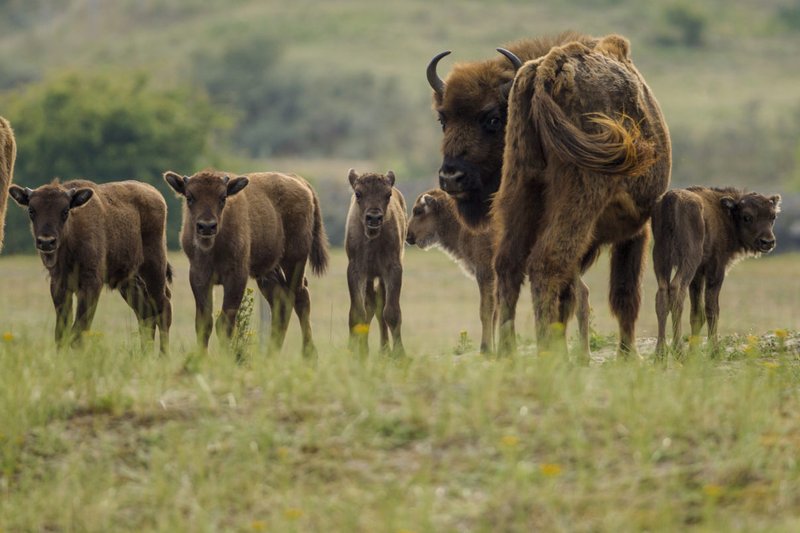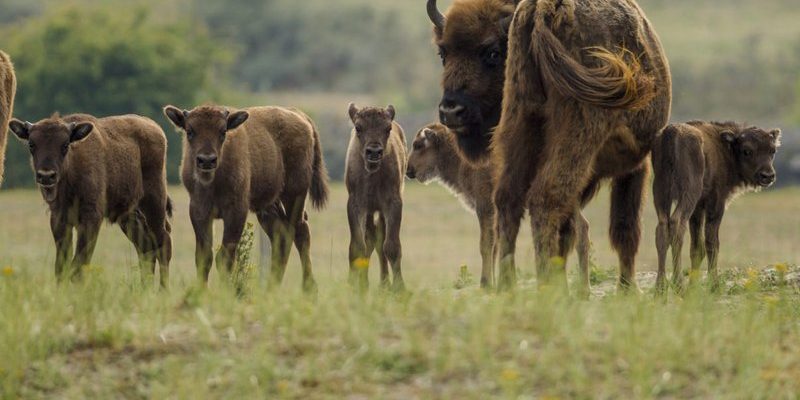
Imagine being a young bison, born into a world full of towering trees and open meadows, where every rustle in the grass could mean food or danger. The bond between a mother bison and her calf is incredibly strong, much like the connection between a parent and child. In this blog, we’ll explore the unique ways European bisons raise their young, the challenges they face, and why understanding their nurturing behaviors matters to the species’ survival.
Birth and the First Days of Life
The journey of a young bison starts with its birth, usually in late spring. As the mother seeks a safe and secluded spot to give birth, she looks for areas sheltered from prying eyes—think hidden glades or dense thickets. The calf is born after a gestation period of about nine months. Surprisingly, they can stand and walk just a few hours after birth. Isn’t that incredible?
During these first days, the calf is vulnerable. The mother keeps a close watch, always alert for potential threats like wolves or other predators. The bond between mother and calf is formed almost instantly. The mother will lick her newborn clean, a vital act that helps strengthen that connection. This behavior also has practical benefits; it helps the calf recognize its mother by scent, which is crucial in a herd environment.
The Role of the Herd
European bisons are social animals and live in herds, which provides safety in numbers. From a young age, the calf learns to navigate its world by observing the adults. You might be wondering how this social structure benefits a newborn. Well, it’s pretty simple: safety! When danger approaches, the herd acts as a formidable barrier, surrounding the young ones while adult bisons fend off threats.
There’s also a communal aspect to raising young in these herds. Other females in the group, known as “cows,” may help protect and even care for calves that aren’t their own. This cooperative breeding practice means that the calves grow up not just under the care of their mothers but with the watchful eyes of the whole herd, teaching them essential survival skills through play and interaction.
Feeding Habits and Nutrition
Once the calf is born, feeding becomes a primary concern. Initially, the mother provides all the nutrition through her milk, which is rich and high in fat—perfect for helping the calf grow strong. As the calf grows, usually within a few weeks, it starts nibbling on grass and other plants, mimicking the adults.
Here’s the thing: European bisons are herbivores, primarily grazing on grasses, herbs, and shrubs. The mother teaches her calf what to eat and where to find the best grazing spots. This knowledge is vital for their survival outside the protected zones. It’s like learning the family recipe for success in the wild, ensuring that the young bison has the skills needed to thrive as it grows.
Social Learning Through Play
One of the most adorable behaviors you’ll see among young bisons is their playfulness. Calves often engage in play fighting, chasing each other, and butting heads—activities that seem like pure fun but are crucial for developing social skills. Through these playful interactions, they learn about their strength, coordination, and how to interact with other members of the herd.
Play isn’t just a leisure activity; it allows young bisons to practice skills they’ll need as adults, like assertiveness and social bonding. These interactions help to establish a hierarchy within the herd, teaching calves their place in the social structure. So, when you see a young bison tumbling through the grass, remember it’s not just being cute—it’s also learning how to survive.
Overcoming Challenges
While raising their young, bisons face significant challenges. Natural predators, habitat loss, and climate change all impact their ability to thrive. In the wild, a calf might not survive if it gets separated from the herd or can’t find enough food. The mother’s vigilance is crucial; she must keep her calf close while also maintaining a healthy distance from the herd to allow for social learning.
Another challenge is the constant need for grazing. With changing seasons, the availability of food can fluctuate dramatically. Mothers must adapt by teaching their calves to migrate to new pastures as needed, ensuring they have access to nutritious vegetation. This adaptability is key for the survival of both mother and calf in the wild.
Mother-Child Bonding
The bond between a mother bison and her calf is incredibly strong. This relationship is built on trust, safety, and the mother’s protective instincts. You might notice how a mother will keep her calf close during grazing or while resting. She uses low grunts to communicate with her young, ensuring it stays near her side.
As the calf grows, this bond allows the young bison to develop confidence. With a watchful mother by its side, the calf begins to explore its environment, eventually becoming independent while still returning to her for guidance and protection. This relationship shapes the future of the young bison, influencing its interactions with other bisons and its overall behavior as an adult.
Why Understanding Their Care Matters
Understanding how European bisons raise their young is not just about the species itself; it reflects broader themes in wildlife conservation. As their natural habitats shrink due to urban development and agriculture, knowing the intricacies of their family dynamics can help conservationists develop effective strategies for protecting these gentle giants.
Conservation efforts often focus on creating protected areas where bisons can roam freely. By observing how they raise their young, we learn which habitat features are essential for nurturing future generations. This knowledge can lead to better policies and practices that ensure bisons can thrive, not just survive.
In conclusion, the way European bisons raise their young blends instinct, social structure, and environmental awareness. Their nurturing practices form a complex web of relationships that enable the next generation of these magnificent creatures to survive and flourish. The world of the European bison is a reminder of the resilience of nature and the importance of understanding and protecting it for future generations.

